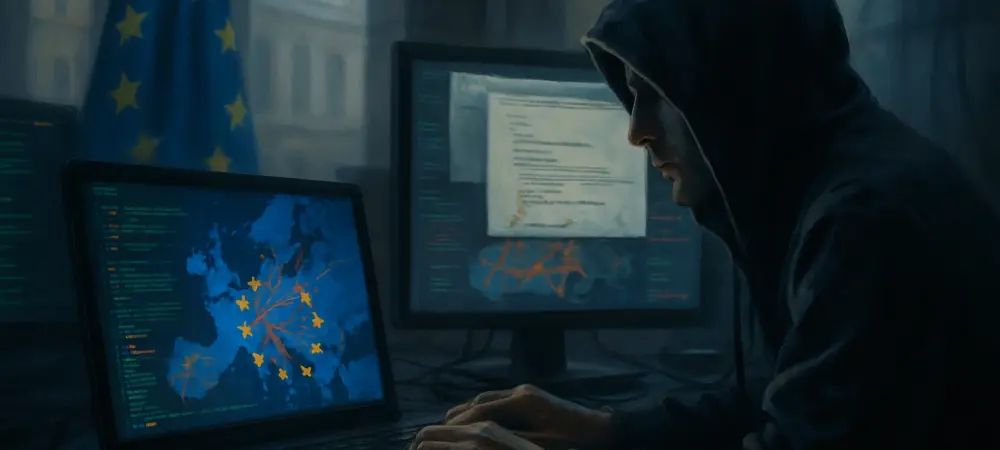In an era where digital warfare shapes international relations, a shadowy threat actor known as UNC6384 has emerged as a significant concern for European diplomatic entities, with a sophisticated cyber-espionage campaign linked to China. This group has zeroed in on sensitive governmental and diplomatic networks across the continent, focusing on organizations in Hungary and Belgium since September, while showing signs of an expanding reach into Italy, the Netherlands, and even government bodies in Serbia. Previously active in Southeast Asia, UNC6384’s shift to Europe signals a strategic pivot in their geographical focus. Their persistent and evolving tactics pose a grave risk to the security of classified information and policy discussions. As state-sponsored cyber threats grow in complexity, understanding the methods and implications of UNC6384’s activities becomes crucial for safeguarding critical infrastructure and maintaining diplomatic integrity in an increasingly interconnected world.
Unveiling the Tactics of a Cyber-Espionage Campaign
UNC6384 employs a blend of technical prowess and psychological manipulation to infiltrate diplomatic networks, showcasing a calculated approach to espionage. Central to their strategy is the exploitation of a high-severity Windows vulnerability, cataloged as CVE-2025-9491, which serves as a gateway for their malicious activities. Their attack chain often begins with spear-phishing emails that lure targets with seemingly legitimate content related to high-profile events like European Commission meetings or NATO workshops. These emails contain malicious URLs leading to LNK files disguised as official documents. Once activated, these files exploit the Windows flaw to execute obfuscated PowerShell commands, paving the way for deeper system compromise. This initial breach highlights the group’s reliance on both advanced exploits and carefully crafted deception to bypass security measures and gain unauthorized access to sensitive environments.
Further into their methodology, UNC6384 deploys the PlugX remote access Trojan (RAT), also known as Destroy RAT or SOGU, which has been a staple among Chinese threat actors for over a decade. Once installed, PlugX enables a range of destructive capabilities, including command execution, keylogging, and establishing persistence within compromised systems. The malware is equipped with anti-analysis and anti-debugging techniques, making it challenging for cybersecurity defenses to detect and neutralize. What stands out is UNC6384’s confidence in leveraging publicly known vulnerabilities, banking on the sophistication of their social engineering to ensure success. Despite global efforts to mitigate such threats, including significant operations by U.S. authorities to dismantle PlugX infections, the malware’s continued use by this group underscores the enduring difficulty of eradicating entrenched cyber threats in diplomatic sectors.
Expanding Reach and Persistent Threats
The geographical expansion of UNC6384’s operations marks a troubling escalation in their campaign against diplomatic entities. Initially focusing on Southeast Asia, the group has now set its sights on Europe, targeting key nations like Hungary and Belgium while showing intent to penetrate networks in Italy, the Netherlands, and Serbia. This broadening scope suggests a deliberate strategy to undermine diplomatic communications across multiple regions, potentially aiming to gather intelligence on a wide array of international policies and negotiations. The shift in focus also indicates an adaptability that challenges traditional cybersecurity defenses, as the group tailors its attacks to exploit regional vulnerabilities and diplomatic contexts. Such a trend emphasizes the need for international cooperation in addressing cyber-espionage, as the implications of these breaches extend far beyond individual nations to affect collective security frameworks.
Beyond the immediate targets, the long-term consequences of UNC6384’s activities are deeply concerning for global diplomatic stability. Successful breaches could lead to the theft of classified documents, real-time monitoring of sensitive policy discussions, and credential harvesting to access broader diplomatic networks. Additionally, surveillance of travel plans and calendars could compromise the safety and privacy of key personnel. These outcomes not only jeopardize national security but also erode trust in international partnerships, as stolen information might be used to influence or disrupt diplomatic efforts. The persistent nature of these threats, driven by state-sponsored actors with access to advanced tools, calls for a reevaluation of current defense mechanisms to prioritize proactive measures over reactive responses in protecting critical governmental infrastructure.
Strengthening Defenses Against Evolving Cyber Threats
To counter the sophisticated methods of UNC6384, cybersecurity experts have outlined several critical strategies for diplomatic and governmental organizations. Recommendations include blocking known command-and-control (C2) infrastructures used by the group to prevent communication between compromised systems and attackers. Conducting thorough endpoint environment searches is also advised to detect and remove any traces of malicious activity before they escalate. Enhancing security awareness training remains a cornerstone of defense, equipping personnel to recognize and resist spear-phishing attempts and other social engineering tactics that serve as entry points for attacks. By fostering a culture of vigilance and ensuring robust technical safeguards, organizations can significantly reduce the risk of falling victim to such cyber-espionage campaigns.
Reflecting on past efforts, it became evident that while international operations had disrupted PlugX infections on a large scale, the resilience of threat actors like UNC6384 demanded continuous adaptation in cybersecurity approaches. Looking ahead, the focus shifted to implementing comprehensive defenses that anticipate the evolving tactics of state-sponsored groups. Collaboration between nations and private sector experts was deemed essential to share intelligence and develop innovative solutions. As the cyber-espionage landscape grew more complex, the urgency to protect sensitive diplomatic networks intensified, prompting a call for sustained investment in cutting-edge technologies and training programs to stay ahead of adversaries.

